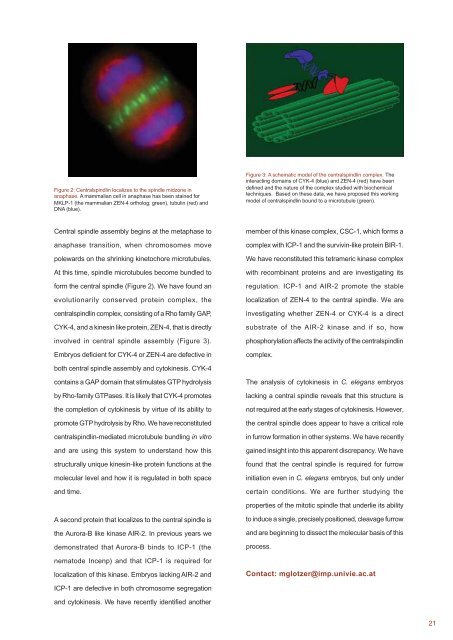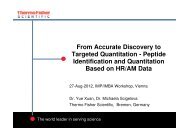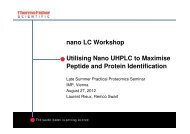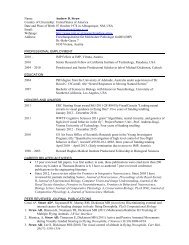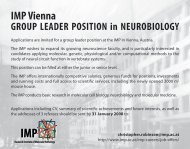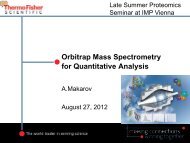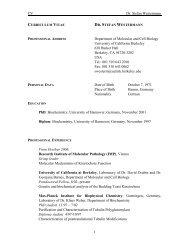IMP Research Report 2002
IMP Research Report 2002
IMP Research Report 2002
You also want an ePaper? Increase the reach of your titles
YUMPU automatically turns print PDFs into web optimized ePapers that Google loves.
Figure 2: Centralspindlin localizes to the spindle midzone in<br />
anaphase. A mammalian cell in anaphase has been stained for<br />
MKLP-1 (the mammalian ZEN-4 ortholog; green), tubulin (red) and<br />
DNA (blue).<br />
Figure 3: A schematic model of the centralspindlin complex. The<br />
interacting domains of CYK-4 (blue) and ZEN-4 (red) have been<br />
defined and the nature of the complex studied with biochemical<br />
techniques. Based on these data, we have proposed this working<br />
model of centralspindlin bound to a microtubule (green).<br />
Central spindle assembly begins at the metaphase to<br />
anaphase transition, when chromosomes move<br />
polewards on the shrinking kinetochore microtubules.<br />
At this time, spindle microtubules become bundled to<br />
form the central spindle (Figure 2). We have found an<br />
evolutionarily conserved protein complex, the<br />
centralspindlin complex, consisting of a Rho family GAP,<br />
CYK-4, and a kinesin like protein, ZEN-4, that is directly<br />
involved in central spindle assembly (Figure 3).<br />
Embryos deficient for CYK-4 or ZEN-4 are defective in<br />
member of this kinase complex, CSC-1, which forms a<br />
complex with ICP-1 and the survivin-like protein BIR-1.<br />
We have reconstituted this tetrameric kinase complex<br />
with recombinant proteins and are investigating its<br />
regulation. ICP-1 and AIR-2 promote the stable<br />
localization of ZEN-4 to the central spindle. We are<br />
investigating whether ZEN-4 or CYK-4 is a direct<br />
substrate of the AIR-2 kinase and if so, how<br />
phosphorylation affects the activity of the centralspindlin<br />
complex.<br />
both central spindle assembly and cytokinesis. CYK-4<br />
contains a GAP domain that stimulates GTP hydrolysis<br />
by Rho-family GTPases. It is likely that CYK-4 promotes<br />
the completion of cytokinesis by virtue of its ability to<br />
promote GTP hydrolysis by Rho. We have reconstituted<br />
centralspindlin-mediated microtubule bundling in vitro<br />
and are using this system to understand how this<br />
structurally unique kinesin-like protein functions at the<br />
molecular level and how it is regulated in both space<br />
and time.<br />
The analysis of cytokinesis in C. elegans embryos<br />
lacking a central spindle reveals that this structure is<br />
not required at the early stages of cytokinesis. However,<br />
the central spindle does appear to have a critical role<br />
in furrow formation in other systems. We have recently<br />
gained insight into this apparent discrepancy. We have<br />
found that the central spindle is required for furrow<br />
initiation even in C. elegans embryos, but only under<br />
certain conditions. We are further studying the<br />
properties of the mitotic spindle that underlie its ability<br />
A second protein that localizes to the central spindle is<br />
the Aurora-B like kinase AIR-2. In previous years we<br />
demonstrated that Aurora-B binds to ICP-1 (the<br />
nematode Incenp) and that ICP-1 is required for<br />
localization of this kinase. Embryos lacking AIR-2 and<br />
to induce a single, precisely positioned, cleavage furrow<br />
and are beginning to dissect the molecular basis of this<br />
process.<br />
Contact: mglotzer@imp.univie.ac.at<br />
ICP-1 are defective in both chromosome segregation<br />
and cytokinesis. We have recently identified another<br />
21


